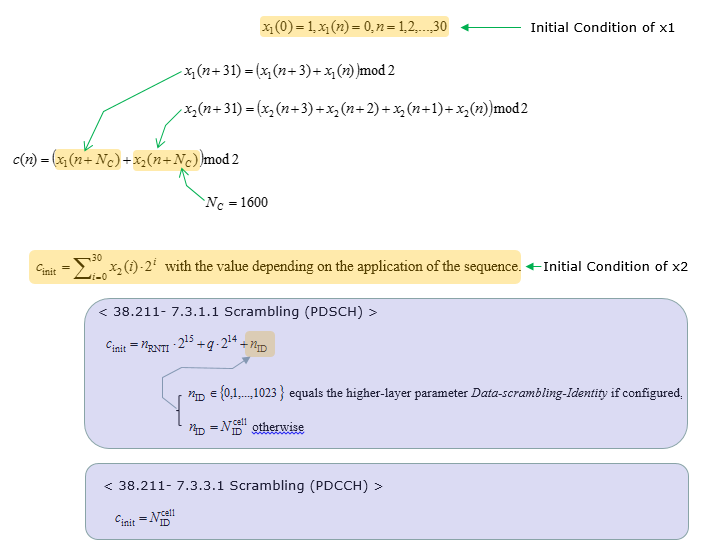|
Pseudo Random Sequence
The Pseudo Random Sequence generation algorithm in NR is same as the one in LTE as shown below. The usage of the sequence is also almost same as in LTE. Only minor difference would be the value initialization part.... overall you may think there is almost no difference from LTE.

As shown in the equations above, in both NR and LTE, the sequences are generated using the same polynomial functions:
- The scrambling sequence c(n) is created by the sum of x1(n + Nc) and x2(n + Nc), modulo 2.
- The first long-term sequence x1(n+31) is updated using the sum of x1(n+3) and x1(n), modulo 2.
- The second long-term sequence x2(n+31) is updated using the sum of x2(n+3), x2(n+2), x2(n+1), and x2(n), modulo 2.
The image text concludes by emphasizing that despite the similarities, there are minor differences in how the sequences are initialized, but overall, they are nearly the same between NR and LTE.
Following is the case showing how pseudo random sequence is being used for PDSCH and PDCCH channel coding process in NR.

- The sequence generation begins with initial conditions for two long-term sequences x1 and x2. The initial condition for x1 is given for indices 0 to 30, while the initial condition of x2 is defined by a given formula.
- The scrambling sequence c(n) is computed using x1 and x2 sequences, combined with a Gold sequence and modulo 2 arithmetic, where Nc is a constant set to 1600.
- For PDSCH scrambling, the initialization sequence cinit is calculated using the RNTI (Radio Network Temporary Identifier), a quarter index q, and the scrambling identity nID. The scrambling identity is either set to a value from 0 to 1023 if configured, or to the physical cell ID NIDcell otherwise.
- For PDCCH scrambling, cinit is directly set to the physical cell ID NIDcell.
Reference
[1]
|
|

